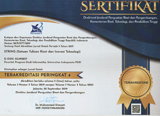Identifikasi Potensi Pembentukan Air Asam Tambang Batubara (PAF /NAF) dengan Menggunakan Metode Uji NAPP (Net Acid Producing Potential)
(1) Universitas Mercubuana
(2) Universitas Indraprasta PGRI
(*) Corresponding Author
Abstract
Several laboratories tests have been developed in Indonesia and another countries that carry out mining activities, especially coal mining. The purpose of this analysis is to find out the presence and absence of soil layers which have the potential to form acidity. The most commonly known analytical methods are static and kinetic methods. The most commonly known method of analysis is static and kinetic methods. Our test this time are uses the NAPP method (Net Acid Producing Potential).Aand then, from the results of this calculation, was known that the mine area had acidic or not. This time, an investigation was conducted to determine the acidity of PAF (Potential Acid Forming) and NAF (Non Acid Forming), which is owned by the mining company PT GIE (Globalindo Inti Energy) at the Handil, Muarajawa, Balikpapan, East Kalimantan regions. From the results of tested and mapped , it was found that this mining area had NAF (Non Acid Forming) soil content, with a PH range between 4.65 - 5.75 and had a negative NAPP price.
Keywords
Full Text:
PDFReferences
Atkinson, T., 1983, Surface Mining and Quarrying, Proc. 2nd Intl. Surface Mining and Quarrying Symposium, Institution of Mining and Metallurgy Bristol, U.K.
Costello, C., 2003, Acid Mine Drainage: Innovative Treatment Technologies, U.S. Environment Protection Agency Report, Report for Office of Solid Waste and Emergency Response Technology Innovation Office, Washington, USA, p. 46.
Gautama, R.S., 2012, Pengelolaan Air Asam Tambang, Bimbingan Teknis Reklamasi dan Pascatambang Pada Kegiatan Pertambangan Mineral dan Batubara, Ditjen Mineral dan Batubara, KESDM, Yogyakarta.
Ian, R., Taylor, J., Pape, S., Yardi, R., dan Bennett, J., 2007, Managing Acid and Metalliferous Drainage, Report for Departement of Industry Tourism and Resources, Australian Government, Australia, p. 95.
Marthen M., 2013, Identifikasi Potensi Pembentukan Air Asam Tambang, NAPP VS NTAPP, Buku Panduan, PT. Trubanindo Coal Mining, Kutai Barat, Kalimantan Timur.
Polawan Malim Sutan. S, 2017, Identifikasi Air Asam Tambang Melalui Metode Uji Statik Pada Tambang Batubara, Jurnal “Gerbang Etam” Balitbangda Kabupaten Kukar Vol. 11 No.1 Tahun 2017.
Sobek, A.A, Schuller, W.A., Freeman, J.R. Smith R.M 1978. Field and laboratory Methods Applicable to Overburden and Minesoils. EPA 600/2-78-054.
Skousen, J.G et.al., 1987, A Review of Procedures for Surface Mining and Reclamation in Area with Acid-Producing Materials. Bekerjasama dengan The West Virginia Surface Mine Drainage Task Force-The West Virginia University dan The West Mining and Reclamation Association, West Virginia U.S.A.
Suits & Arthur. 2000, Sulfur Diagenesis and Partitioning in Holocene Peru Shelf and Upper Slope Sediments. Chemical Geology, Isotope Geoscience, Vol 163. Elsevier.
Stewart, Warwick, 2005, Development of Acid Rock Drainage Prediction Methodhologies for Goal Mine Wastes. Ian Wark Research Institute University of South Australia, Australia.
DOI: http://dx.doi.org/10.30998/string.v4i1.4274
Refbacks
- There are currently no refbacks.
Copyright (c) 2019 Baskara Widy Artyanto Putro, Diyan Parwatiningtyas

This work is licensed under a Creative Commons Attribution 4.0 International License.
STRING (Satuan Tulisan Riset dan Inovasi Teknologi) indexed by:

Ciptaan disebarluaskan di bawah Lisensi Creative Commons Atribusi 4.0 Internasional.
View My Stats

 Sertifikat Akreditasi
Sertifikat Akreditasi
















